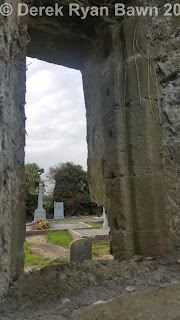This is a view that not many people get of Tyone Abbey as when you pass it on the Thurles Rd it seems like the small remains of a fairly basic ruined church.
Another view that most people don't get is the perilous state of this very important building which is the oldest religious building in Nenagh.
This arch in the main section of the abbey is in a very precarious state.
 |
| Other side of the arch |
I happened to meet the landowner of the surrounding lands when I visited. He thought that I was from the OPW and wanted to talk to me about vital repairs that are required to make these monuments safe. Unfortunately he told me that the site is stuck in a bit of a bureaucratic limbo with a number of different bodies involved in it and none wanting to tackle the issues here.
It is my own personal view that this arch will not last another winter here if we get storm winds like the last few winters. This arch is a vital structural component of the north wall of the abbey.
On a brighter note here is some information on the site from the onsite information board:
"Was founded about 1200AD, by Theobald Butler, who also founded Nenagh Castle. It was given to the Canons of St. Augustine, they were famous as preachers. It was dedicated to St. John the Baptist, hence the name Tig Eoin (Tyone), the house of John. The Monks, who wore black, were obliged to care for the sick and traveler.
Irishmen were forbidden admission as monks, but this changed with the decline of Norman power. The monastery held a considerable acreage of land and tithes of over a dozen parishes. The now ruinous building would have consisted of a dormitory, refectory, kitchen, sick bay, church and cloister."
I've not seen any reference to what look to me like some architectural fragments installed in this north wall of the abbey. The one marked with the red arrow looks to me like a carving of some kind of animal.
Another interesting features is this standalone bit of masonry which I understand was part of a staircase at one stage.
And from within the window of this feature.
One piece of interesting folklore I found relating to the abbey relates to a secret passage linking it with Nenagh Castle.
http://www.duchas.ie/en/cbes/4922136/4855793
"There is a secret passage from the Nenagh Castle to Tyone Abbey, to Lisboney and to Barrach St. Abbeys."
As they say, there is always a secret passage!
Another piece I found in an old Nenagh Guardian article:
Nenagh Guardian - 31-12-1932
"
An unusual piece titled "The Fairies of Munster" -"Did you ever hear of a place called Nenagh?" he asked "Yes" said I "I have heard of it" Well "said he "I was born and reared within a few miles of that town" "It is a fine town, I suppose" said I "Well, it is and it isn't" he replied. "It is a great place for fairs, to be sure. In fact, the original name of the town was Aonach, which meant a fair. "At one time there used to be a great fair at a place called Tyone, a mile or so outside the town, every 1st August. In fact that date was known locally as the "1st of Tyone". It was not far from a rath, known as Rathurles, and the fairies from there gave so much trouble at the fairs that they had to change the fair to the town." "Not into the town surely" said I, "there must be a fair green in such an important town". "There is not; then" said he "The cattle are in the very streets and right up against shop windows" I suppose the idea is "said I "that the shopkeepers want to keep the trade at their doors". "By no means" said my friend "but they are afraid if they hold the fair outside the town the fairies might interfere with it, for they are averse to the smoke and dirt of a town. They love the fresh air, and that is the reason there is no fair green in Naenagh". "Well now" said he "it was in this district I was in the fairies and next time we meet I will tell you about my experiences during the seven happy years I spent amongst them" - it is signed off as "Old Boy".
For more detailed information on the history of the abbey, Dermot F. Gleeson wrote about it here
http://www.jstor.org/stable/25510135 -
I haven't found a freely accessible version so if anyone knows of one please pass it on to me.







